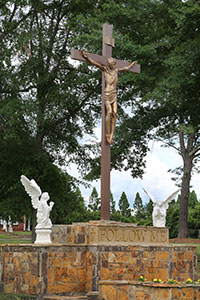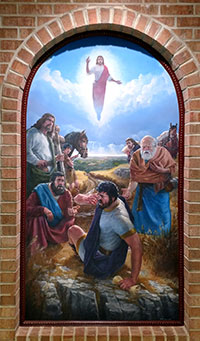 FOREST CITY — A new 20-foot crucifix standing outside Immaculate Conception Church was blessed May 16.
FOREST CITY — A new 20-foot crucifix standing outside Immaculate Conception Church was blessed May 16.
The blessing was done by Monsignor Mauricio West, vicar general and chancellor of the Diocese of Charlotte.
The new landmark, which faces the highway next to the church, was designed by Father Herbert Burke, pastor. It stands 20 feet high with eight-inch wide beams made of aluminum. At its base are featured Christ’s words: “Follow Me.”
“The plan was to have a continuous witness to the love of Christ next to the highway, so that everyone passing by could see the sacrifice of Christ on the cross, and hopefully be inspired by His love to make the right decisions in their lives,” explained Father Burke. “The words ‘Follow Me’ are given to Peter at the end of the Gospel of John, when He tells him that he will give his life as a martyr to be crucified for the glory of God (John 21:18-19).”
Father Burke said that he spent about a month designing the project and coming up with the measurements on paper. Then he began to recruit helpers for the work and suppliers for the materials.
He particularly credited Gerardo and Salomon Mendoza, who fabricated the aluminum cross and painted it brown; Deacon Sigfrido Della Valle, Efren Ramirez and Guillermo Cabrera, who were involved in lifting the cross, mounting the corpus and concreting it in place; Cuatemock Melgar, the mason who did the stone work; and Danny Suhy, who made the concrete sign and mold for the words “Follow Me” at the base of the cross.
The six-foot corpus was supplied by Mazzolini Art Works, and the praying angels positioned next to the cross came from Maise Manufacturing in Forest City.
— Giuliana Polinari Riley, correspondent
 GREENSBORO — An original painting depicting the Conversion of St. Paul was installed recently at St. Paul the Apostle Church.
GREENSBORO — An original painting depicting the Conversion of St. Paul was installed recently at St. Paul the Apostle Church.
The 72-inch-by-40-inch acrylic ink on wood panel work depicts the key moment when Jesus appears before Saul as he heads towards Damascus in order to persecute the followers of Christ. Greensboro artist and illustrator Erik Shea Saalmuller created the piece, working 400 hours over four months in consultation with Father Joseph Mack, pastor.
Based on research, Saalmuller created the composition to include the following points:
- At the time of his conversion, Saul was less than 30 years old and held a position of authority among older Pharisees. His conversion occurred en route to Damascus, located in modern-day Syria. The landscape is primarily plains and flat stretches of land, with mountains and hills breaking up the terrain
- Most Renaissance paintings, in which Saul is shown being tossed from his horse as Jesus appears before him, were probably inaccurate. As a devout Jew, Saul would have kept to the traditions of his forefathers by praying three times a day: morning, noon and evening. In his own recollection recounted in the Acts of the Apostles, St. Paul said he saw Jesus appear before him at midday, which would have coincided with the time of his prayers. Even if he had a horse to help ease the burden of traveling the long distance from Jerusalem to Damascus, he would not have been mounted on horseback at the time Jesus appeared. This led Saalmuller to show St. Paul as if he fell while walking the path, rather than depicting the horse in a chaotic bucking motion.
 -In the Bible passage, Jesus appears before Saul on the road to Damascus, but the other men accompanying Saul on his journey could only hear, not see, Jesus. Since the men could not see Jesus, they would naturally either look around, or reach out to help the now-blind Saul, who to their minds was being afflicted by something far beyond their understanding.
-In the Bible passage, Jesus appears before Saul on the road to Damascus, but the other men accompanying Saul on his journey could only hear, not see, Jesus. Since the men could not see Jesus, they would naturally either look around, or reach out to help the now-blind Saul, who to their minds was being afflicted by something far beyond their understanding.

